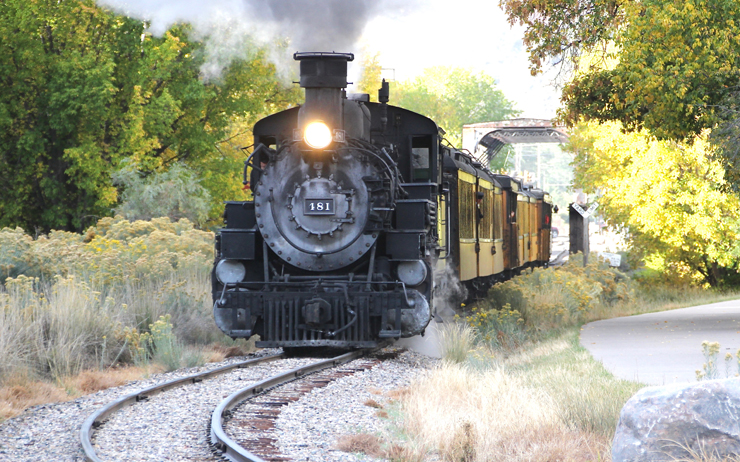Monday morning rail news:
— The Durango & Silverton has extended its shutdown to an undetermined June date while trying to figure out how to succeed financially while operating under social-distancing requirement. American Heritage Railways General Manager John Harper told the Durango Herald that while the railroad is considering operating at 50%, 60% and 75% of ridership capacity, “the difficult perspective for us is that we can’t cover our costs operating a train below 75% of capacity.” The railroad may initially operate shorter trips — from Durango to Cascade Canyon or Rockwood to Cascade Canyon — it aims to operate to Silverton later in the season. Another hurdle, though, is that San Juan County, which has had only one confirmed case of COVID-19, is wary of allowing visitors into Silverton.
— Caltrain, the San Francisco-San Jose commuter rail service, could shut down completely if it cannot find new revenue sources, even after the Bay Area’s shelter-in-place order ends. “The status quo is not acceptable,” Caltrain General Manager Jim Hartnett said at a board meeting last week, the San Mateo Daily Journal reports. “The search for external funds in addition to other adjustments is going to be a very serious effort.” Harnett was one of 15 chief executives of major transit systems who signed Friday’s letter to Congress asking for $32 billion in emergency aid for those systems [see “Transit agencies seek $32 billion in additional federal aid,” News Wire Digest, May 9, 2020]. Caltrain revenue has been particularly hard-hit by the coronavirus pandemic because 75% of its operating revenue comes from tickets and parking — and ridership is down 98%.
— New York’s Metropolitan Transportation Authority allowed homeless people to shelter in out-of-service buses during Saturday’s overnight closure of the subway system, but said the measure — taken when unseasonably cold weather drove wind chills into the 20s and brought a trace of snow — would not be repeated. ““We are providing these buses only during this cold snap and expect the city to continue to step up and take responsibility for providing safe shelter for those individuals experiencing homelessness,” interim New York City Transit President Sarah Feinberg said, as reported by amNewYork.com. “As we have stated many times, we are transportation providers, not a social services agency.” Some 384 homeless individuals were engaged in the subway system on Saturday night, according to Mayor Bill de Blasio, with 198 accepting help from city agencies.















The homeless may be divided into three groups: the have nots, the can nots and will nots. The do not fit the stereotype. They wil accept any help, and work themselves out of their predicament. The can nots, surfer from either physical or mental ailments. Most of them need professional care, but the laws changed about forty years ago such that you can not force someone to get help. I do not know what to do for them. The will nots are the professional homeless, whatever we do for them perpetuates their existence. However, most politicans do not that by helping them, you are hurting them. I leave it to professionals, to work with them, by supporting their employers usually non-profits. In Santa Barbara their visibility is inversely proportionately to the temperature.
I didn’t know that the MTA was in the hotel business.
GERALD and IAN – I don’t know the solution to alcoholic, drug addicted losers disaffiliated from society. I know what the solution is not: allowing them to inhabit buses and subways. Those are for paying customers going from place to place. As far as streets and sidewalks, those too are for people going about their legitimate business. All else requires a permit. A hot dog stand, a political demonstration, an outdoor concert, anything that might interfere with streets and sidewalks all require a permit. So should living in the street. Anyone who can’t prove a legitimate purpose and basic hygeine should be denied. There is no right to live on the street just because it’s public property. President Trump’s bedroom is public property. That doesn’t give anyone the right to pitch a tent in there.
Ian NaritaFor most of these homeless it’s a choice they’ve made to live that way, and so having chosen to do so they should live with the consequences, which includes extremely cold night which might be detrimental to their health or lives. Go ahead and call me heartless but I’ve always thought let them fend for themselves, those that have chosen the lifestyle need to deal with it. Those that didn’t can get help for their mental issues.
Sheltering people on buses was not a first choice. Given that people are afraid of shelters(people get stabbed in public overnite shelters) , rather then risk people dying in the streets after being kicked off the subway, New York’s MTA did what they could with what resources they had. I would think that the buses used for the decontamination treatment when the overnite “route” ended.
We’ll shelter the homeless on buses but we won’t shelter the homeless on buses. Double plus ungood duckspeak from New York’s commie mayor. PS Anyone want to ride that bus the next morning ?????